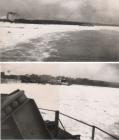27
FERRYMEN EMBREE and WALKER - Captain James Embree of Port Hawkesbury is credited with being the first operator of a vehicle carrying ferry in the Strait of Canso in 1913. His father ran a private ferry before him. James' ferry was a flat bottomed scow pulled by a kind of sail boat or it was rowed.In 1922, Captian P.J. Walker was granted the monopoly on ferrying automobiles across the Strait of Canso. His ferry was built as a landing barge for WW I but he refurbished it to become the Edith C. Walker in 1925. In her last year of operation, 1925, the Edith C. Walker ferried a total of 2,904 automobiles.
28
Car ferry crossing between Mulgrave and Port Hawkesbury. Harbour of sailing ships at Port Hawkesbury1910
Strait of Canso, Nova Scotia, Canada

29
The first ferries in the Strait of Canso were not much more than a scow pulled by a boat. In the top picture, c. 1910, an early ferry operator transports a car across the Strait.The lower picture shows a local resident in a rowboat among large vessels in Port Hawkesbury's harbour.
When conditions in the Strait were right, anybody with a small craft could make the crossing but with the strong currents, it was a challenge at the best of times and almost impossible in winter.
30
The Pont de Canseau crossing the Strait of Canso circa 19261926
Strait of Canso, Nova Scotia, Canada

31
GOVERNMENT OPERATED AUTOMOBILE FERRIES BEGIN OPERATIONS - On July 1,1926, car/passenger ferries came under the control of the Nova Scotia Department of Highways. The first government car ferry was the Pont de Canseau, which held ten automobiles. Later came the [Breton] which operated in 1927-28.33
The Sir Charles Tupper, brought into service in the Strait of Canso in 1928, was the largest of the government fleet's first ferries. With a capacity of 18 vehicles, the ferry helped meet the increase in traffic across the Strait. This photo (c. 1940) shows the Tupper at the government wharf in Port Hawkesbury.34
Welcome to Cape Breton Sign in frnt of the Baptist Church on Granville Street1940
Port Hawkesbury, Inverness County, Nova Scotia, Canada

35
Car ferry docks in Port Hawkesbury on the top and Mulgrave on the bottom.1947
Strait of Canso, Nova Scotia, Canada

36
1930's PONT DE CANSEAU and SIR CHARLES TUPPER AT WHARF - In Port Hawkesbury, the car ferries unloaded at a wharf just south of the current government wharf. From this location, cars leaving the ferry were just yards from Granville St., Port Hawkesbury's main street at the time.The Mulgrave auto ferry dock was north of where the current Mulgrave Superport facility is located. This picture, c. 1950, shows the John Cabot having just departed Mulgrave for Port Hawkesbury. (NS Public Archives Photo)
The sign advertising local handcrafts at the Shanty by the Sea was located in the home of Mrs. Lillian Williams, Mulgrave. She celebrated her 106th birthday on June 16, 2004 still passonate about her home town of Mulgrave.


